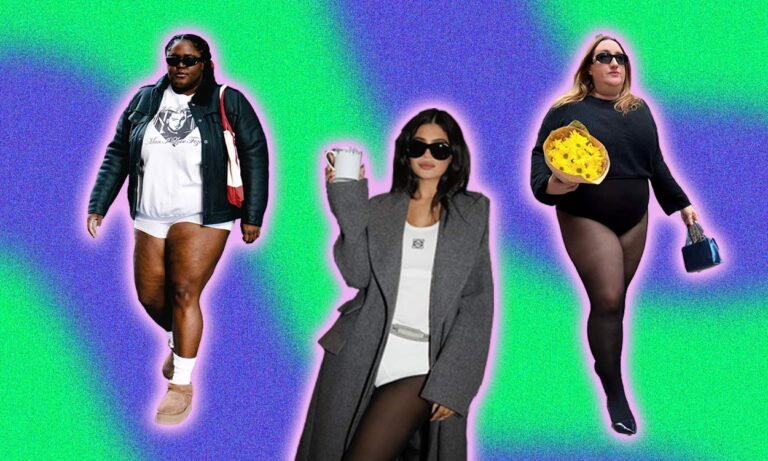From Bella Hadid to Kendall Jenner, why did everyone stop wearing trousers? The no pants trend, explained

By now, you’ve probably seen the photos. Kylie Jenner looking chic in Loewe briefs, Bella Hadid eating pizza in tighty-whities paired with a leather jacket, and Camila Mendes attending New York Fashion Week in… not much.
Long story short, it seems that underwear is in and pants are out. So, when did everyone stop wearing bottoms, you might be wondering. The answer? The no pants trend has been happening gradually, but sightings have skyrocketed in recent months. Here, find out why trousers have disappeared and how you can embrace the trend to enter your no pants era too.
So, when did it start? The barely-there style has its origins in the ‘lampshading’ silhouette that was popular in the mid to late-2010s. Favoured by the likes of Ariana Grande, Rihanna and Kim Kardashian, this iteration of the no pants trend manifested as baggy hoodies, billowing blouses and oversized blazers often paired with thigh-high boots.
In fashion editor Kendall Becker’s words, the trend was “all about a peak of skin,” whereas the no pants trend “embraces the whole leg for a more streamlined and minimalistic look.” As we shifted into the 2020s, bike shorts reigned supreme, hinting at what was to come.
More recently, we’ve seen the micro-mini skirt as well as the subtle emergence of skinny trousers and leggings on the runways once again, says Becker. The latest iteration of this trend, however, opts for bottoms that are even teenier and tinier—or sometimes not even there at all.
While the no pants look dominated fashion weeks earlier this year, the trend has also become a staple of street style. And, if we were to name a leader of the sans trousers club, it would have to be the internet’s most divisive nepotism baby, Hailey Bieber, who’s been championing the look since 2019.
This begs the question: Is the no pants trend actually stylish, or are those wearing it just skinny? Teen Vogue journalist Aiyana Ishmael tested out a few of Bieber’s pants-less looks to see if they worked for plus-sized people, including a micro-mini moment. The verdict? Ishmael noted how, “after walking around the office, many of my coworkers and colleagues agreed that this look is, in fact, my look.”
View this post on Instagram
While it’s not quite the no pants trend, Ishmael pointed out how “everyone deserves to wear micro skirts” and that “styles should come in all sizes.” Sarah Chiwaya, writer and founder of NYC Plus, an IRL community for plus-sized individuals, also took the trend out for a spin by emulating Kendall Jenner’s Bottega Venetta fit. “All in all, it was a pretty enjoyable experience,” Chiwaya concluded. However, the writer reminded readers to be cautious of “body as accessory” trends like this one.
View this post on Instagram
As Chiwaya sees it, “this trend mimics the head-turning sensibility that makes a street-style or Instagram statement, but it doesn’t have the staying power of wearability and comfortability––two factors necessary for a powerful trend.”
Another stylistic note to consider is that most of the underwear sported by celebrities embracing this trend are menswear-inspired or straight-up men’s briefs. This adoption of accessories traditionally associated with men echoes the similar tie trend that has taken off recently. Menswear as womenswear is nothing new, but there has been an uptake in gender-neutral underwear styles recently (think the iconic Skims briefs) that might also be feeding into the trend.
View this post on Instagram
While the style might seem impractical at first glance, it may actually be a comfy solution to an edgy night-out look. Some no pants fits could even be a variation of balletcore. Take Kendall Jenner’s sunflower-adorned ensemble, for instance.
So, why is this trend happening now? “Fashion is just expressing what’s going on broadly in culture,” business of culture journalist Christina Binkley told USA Today. “We’re in a rule-breaking era.”
Gen Z is known to push the envelope when it comes to fashion, so ditching trousers doesn’t seem to come out of left field. It also may have connections to the sheer moments we’ve been seeing on red carpets this year—think Florence Pugh’s stunning Valentino ensemble, she’s still wearing a skirt, but her underwear is still very much a main accessory. In contexts like this, the sans pants trend could even be understood as a post-Roe v. Wade response to body autonomy.
The final verdict? “This trend certainly does not scream comfort,” concludes Becker. “It’s a hard ask to expect a consumer to wake up in the morning and reach for a no-pants look before heading off to work.” But if you’re looking to give the eye-catching trend a go, Becker suggests layering “an oversized blazer overtop for a bit of extra comfort.”




